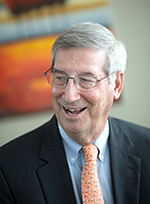On top of investing and planning guidance, what families are really looking for is advice on the most important issue: their family legacy.
by Bob Killebrew, Senior Strategist
Here’s something you don’t hear anymore: stockbroker jokes. It was so cold today I saw a stockbroker with his hands in his own pockets. Or, My broker and I are working on a retirement plan—unfortunately, it’s his! Then there’s the Woody Allen quip, “A stockbroker is someone who invests other people’s money until it is all gone.” Back in the day there was even a joke about stockbroker jokes: What's the problem with stockbroker jokes? Stockbrokers don't think they're funny, and normal people don't think they're jokes.
Maybe those one-liners were tired even when they were timely. But revisiting these wisecracks is a good reminder of how much our industry has changed. I often explain how far we have come to my younger colleagues at WMS. In fact, I think that recognizing how our industry has evolved over the decades—from advisor-focused to client-focused—is critical to understanding what we need to do today and in the future.
THE EVOLUTION OF FINANCIAL ADVICE
The Old Days—The 50s, 60s, and 70s.
Up through the 1970s, financial advisors were brokers. They were compensated by commissions based on the type and volume of stocks and bonds they sold to their clients. Looking back, this gave brokers the wrong incentives. Brokers sold what ought to have been given away—the execution of buy and sell orders—and gave away what ought to have been sold—the financial advice that investors needed. High commissions and frequent trading often resulted in two parties—brokers and “brokees” (the clients), as the old joke goes.
A Better Arrangement—The 80s.
Then came the go-go 80s. Recognizing the conflicts of interest inherent in commission-based compensation, leading firms in the industry moved toward charging a fee calculated as a percentage of the client’s portfolio. This was clearly a better arrangement for clients. Advisors still acted as portfolio managers, buying and selling specific securities for each client account. While some were better at it than others, most added little value.
Finding the Best—The 90s
As the 90s arrived, firms started to realize that relying on advisors to be experts in all kinds of stocks and bonds was asking too much, and the concept of “open architecture” grew in popularity. Here, advisors built portfolios not by selecting specific securities, but by using outside fund managers from whatever asset-management company they thought best—ABC blue-chip stock manager and XYZ muni bond manager. This transformed the role of the advisor into that of an investment consultant, searching the investment landscape for the best portfolio managers. At the same time, thanks in large part to Jack Bogle at Vanguard, passive investingwith low-cost index funds came onto the scene as well. Indexing challenged the assumption that most portfolio managers can outperform the benchmark over time.
A Better Plan—The 2000s
In the 2000s, the industry moved beyond investing to embrace wealth planning, which seeks to ensure that clients’ taxes, estates, insurance and financial planning are all well-coordinated and in order. This welcome change was driven by the realization that maximizing portfolio returns for clients is not enough if those gains are offset by taxes and poor estate outcomes. Advisors became holistic financial coordinators, pulling together teams of inside and outside experts to create sophisticated wealth plans.
The Big Picture—Today
So where does that leave us today? I believe that once families are well invested (using a fee-only, open-architecture, active and passive investing approach) and well planned (with sophisticated and coordinated wealth-planning advice), there’s one remaining gap that families need help filling. Namely, they need help ensuring that their wealth actually makes their families as happy and fulfilled as possible. At WMS, we call this family-legacy planning. Family-legacy advice focuses on the big-picture issues:
- What are your family’s most deeply held and shared values?
- What’s the best way to transfer those values to the next generation?
- How can you ensure your wealth creates a safety net for your kids, but not a hammock?
- What does happiness and success really mean for your family?
- What positive impact can your family leave on your community and the world?
Family-legacy issues are a long way from the smoky days of 1970s stockbrokers. At first blush, they may seem much softer than the rigorous analysis that goes into investing. But there has been an enormous amount of fascinating research—in psychology, behavioral finance, and neuroscience, among others—into family-legacy issues.
We will be bringing you thoughts on these topics regularly in the coming weeks and months, so watch this space and feel free to share these blog posts with your friends and family. As always, let us know what’s on your mind. As this history lesson illustrates, it’s only by listening to clients that our industry moves forward.

Bob Killebrew is a Partner, Senior Strategist of the Investment Committee, and a member of the Executive Committee. Bob works closely with his clients advising them on asset allocation and portfolio composition. A Chartered Financial Analyst (CFA®) charter holder, Bob is a past President of the Baltimore Chartered Financial Analyst Society.
Related Posts
Martin Eby Named a Top 50 Wealth Advisor by Forbes
WMS Partners is pleased to announce that Forbes has named Martin Eby to its list of America’s Top...
WMS Operational Update
We extend our thoughts and wishes for good health and safety as you, your family and loved ones...
WMS Partners Recognized as a Top Registered Investment Advisor by the Financial Times
July 7, 2018 – Towson, MD – WMS Partners is once again one of the top 300 Registered Investment...

